

"The Sun of Righteousness...

This symbol, which appears over the pylons or gates of many Egyptian palaces and temples, is emblematic of the three persons of the Egyptian Trinity. The wings, the serpents, and the solar orb are the insignia of Amen, Ra and Osiris.
Amen the hidden One
Ra the sun symbol of the Most High Creator
Osiris the one who is raised
from the dead [resurrected].
...with healing in his wings"
Malachi 4:2
Amen: The worship surrounding Amun, and later, Amun-Re represented one of ancient Egypt's most complex theologies. In his most mature form, Amun-Re became a hidden, secret god. In fact, his name (Imn), or at lest the name by which the ancient Egyptians called him, means "the hidden one" or "the secret one" In reality, however, and according to mythology, both his name and physical appearance were unknown, thus indicating his unknowable essence.
Emmunah/Emunah in Hebrew means faith/verity. It is also associated with the manna, the heavenly bread given to the Hebrews on the Exodus That bread was associated with the soul of Moses. the surest for Immanuh is Imn as in Amen or Amun.

The Bread and The Sun
John 6:48-58 (KJV)
I am that bread of life. 49 Your fathers did eat manna in the wilderness, and are dead. 50 This is the bread which cometh down from heaven, that a man may eat thereof, and not die. 51 I am the living bread which came down from heaven: if any man eat of this bread, he shall live for ever: and the bread that I will give is my flesh, which I will give for the life of the world. 52 The Jews therefore strove among themselves, saying, How can this man give us his flesh to eat? 53 Then Jesus said unto them, Verily, verily, I say unto you, Except ye eat the flesh of the Son of man, and drink his blood, ye have no life in you. 54 Whoso eateth my flesh, and drinketh my blood, hath eternal life; and I will raise him up at the last day. 55 For my flesh is meat indeed, and my blood is drink indeed. 56 He that eateth my flesh, and drinketh my blood, dwelleth in me, and I in him. 57 As the living Father hath sent me, and I live by the Father: so he that eateth me, even he shall live by me. 58 This is that bread which came down from heaven: not as your fathers did eat manna [firm steady truth or faith], and are dead: he that eateth of this bread [assurance/faith] shall live forever.
Why did they say this different bread will bring eternal life? Because a element was missing, not in the BREAD but in the eaters of the bead.
Hebrews 4:1-3 "Let us therefore fear, lest, a promise being left [us] of entering into his rest, any of you should seem to come short of it. For unto us was the gospel preached, as well as unto them: but the word preached did not profit them, not being mixed with faith [pistis] in them that heard [it]. For we which have believed do enter into rest, as he said, As I have sworn in my wrath, if they shall enter into my rest: although the works were finished from the foundation of the world."
The same gospel was preached to the Exodusing Israelites as was preached to those in he book of Hebrews thousands of years later. There is nothing new under the SUN!
Emmunah the bread for life eternal:
"It is the function of the soul of Moses (present in every generation) to sustain and reinforce the consciousness of the faith of Israel, and hence Jewish identity, through the food of Torah wisdom. In the merit of Moses, manna was given to Israel. Its first appearance in Torah reads "man hu," which permutes into the word "emunah."
Moses as we have know being a title of a man and not the name of a man. Mos is actually a "Son of or child" and should be affixed to the name of a deity.
"As stated by Freud, the word Mos, in Egyptian means "child". In Egyptian names it is a suffix, such as Tut - mosis, which means "Tut's child", Ptah - mosis, Amun - mosis, and so on."
The deity being first associated with Moses was fire via the burning bush. That symbol was the solar disk.
"Emunah is the spiritual state associated with the inner experience of the highest of the three "heads" of keter, the Reisha d'lo Ityada ("the unknowable head")"
The Hebrew Emunah can be spelled Immunah and in Swahili it is Imani which is also means faith or belief. So that same Hebrew word and it reference to the Biblical Moses has a root n the Sun of Righteousness and the manna from Heaven. The manna representing sustenance on the surface also represented in the hieroglyphs as a conical shape like the sun rays.
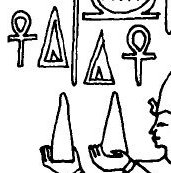

The heiroglypic word for Hetep, meaning "offering" or, as a verb, "to be content": a conical loaf of bread on a reed mat.

The Egyptians' staple food was bread. It was made from barley and emmer wheat, their most common crops. Bread was usually baked in a conical mold that was placed over an open fire. There were also dome-shaped ovens where net loaves of bread were baked by placing them against either the hot interior or exterior of the dome.
The Egyptian bread was also called shewbread like the sacred bread used by the Israelites in the Temple built by Bezalel.
Exodus 31:1-11
"And the LORD spake unto Moses, saying, See, I have called by name Bezalel the son of Uri, the son of Hur, of the tribe of Judah: And I have filled him with the spirit of God, in wisdom, and in understanding, and in knowledge, and in all manner of workmanship, To devise cunning works, to work in gold, and in silver, and in brass, And in cutting of stones, to set them, and in carving of timber, to work in all manner of workmanship.
Why would Bezalel a goldsmith, make the shewbread out of wheat for the Temple of Israel? He may have made it of gold as a symbol for RE and the symbol of the Sirius the dog star which is know as the 'sun of the sun' or the sun's heart.
Ages in Chaos" Velikovsky writes:
"Next to the altar was the table "whereupon the shewbread was" (I Kings 7:48; II Chronicles 4:19). The showbread was obviously not of flour, but of silver or gold; in the Book of Exodus12 it is said that showbread was made by Bezalel, who was a goldsmith. Showbread is pictured on the bas-relief of Karnak in the form of a cone. The cone in the seventh row (138) bears the explanation: 'White bread." This bread was of silver. The thirty cones of gold (48) and the twenty-four cones of colored stone (malachite) (169), identical in form with the silver cone, also represent showbread."
The astrological glyph for the sun, and the alchemical symbol for Gold. This symbol originated in ancient Egypt as a symbol for the sun God Re.
Is this the symbol of manna and the shewbread taken from Egypt by the Mos[es]? Who was not making another religion, but was giving the people in the Biblical Exodus, the same religion in which he had been trained. Sirius the Dog star is 20 times brighter than our sun.
Acts. 7:22 " And Moses was
instructed in all the wisdom of the Egyptians: and he was mighty in his words
[speech] and in his deeds [works]. "
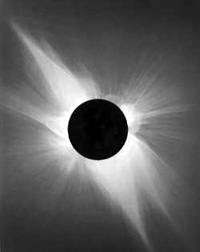
Sun's Corona
Ra/Re: The common Egyptian term for the sun, thus making him [The Amen or the Invisible One] "the visible". Hence, Amun-Re combined within himself the two opposites of divinity, the hidden and the revealed. As Amun, he was secret, hidden and mysterious, but as Re, he was visible and revealed.
"God revealed himself to humanity through his Son [the revealed], Jesus Christ, who is "the radiance of God's glory and the exact representation of his being" (Hebrews 1:3). Jesus called God his Father (Matthew 10:32-33; Luke 23:34; John 10:15) and said, "Anyone who has seen me has seen the Father [the hidden]" (John 14:9). He boldly claimed, "I and the Father are one" (John 10:30). After Jesus' resurrection, Thomas addressed him as "My Lord and my God!" (John 20:28). According to the scriptures Jesus Christ was the revealed God."
Once known as Amon-Re, he the was depicted in human form wearing a headdress, and wore all of the symbols of supreme power. The symbol was an attribute and was not worshipped as a ram or lamb.
As Amon Kneph, he was seen with the head of a sacred ram/lamb.
He usually had horns that curved downward, a characteristic common to rams in the Nile region. He was also commonly portrayed with wings.
Revelation 13:8 "All inhabitants of the earth will worship the beast -- all whose names have not been written in the book of life belonging to the Lamb that was slain from the creation of the world."
Revelations
The Throne of God and the Lamb
Above in the picture there is the cone shaped of the sun[ rising] and in the midst of the throne is the pyramid sitting atop the square and then seven stars.
Here we have the name of Auset [Isis] with two of the same symbols used above.
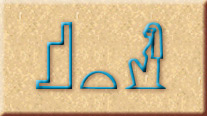
The throne or square step, the loaf or semi-circle for the bread symbol, which is the T or TH sound.
![]()
The Bread and the Sun [semi-circle]

The Bread of Life [cone shaped]
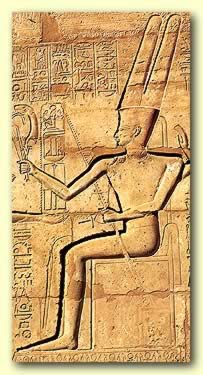
Amen Re sitting on the square or Throne
Seven stars: The Bible contains three direct references to the Pleiades in Job 9:9 and 38:31, and Amos 5:8, and a single indirect reference in the New Testament. This latter passage (Revelation 1:16) describes a vision of the coming of the Messiah – who holds, in his right hand, seven stars…
Here is a ancient German rendition of the bread, star connection. Called the 'Nebra Star Disk' or 'Sangerhausen Star Disk'
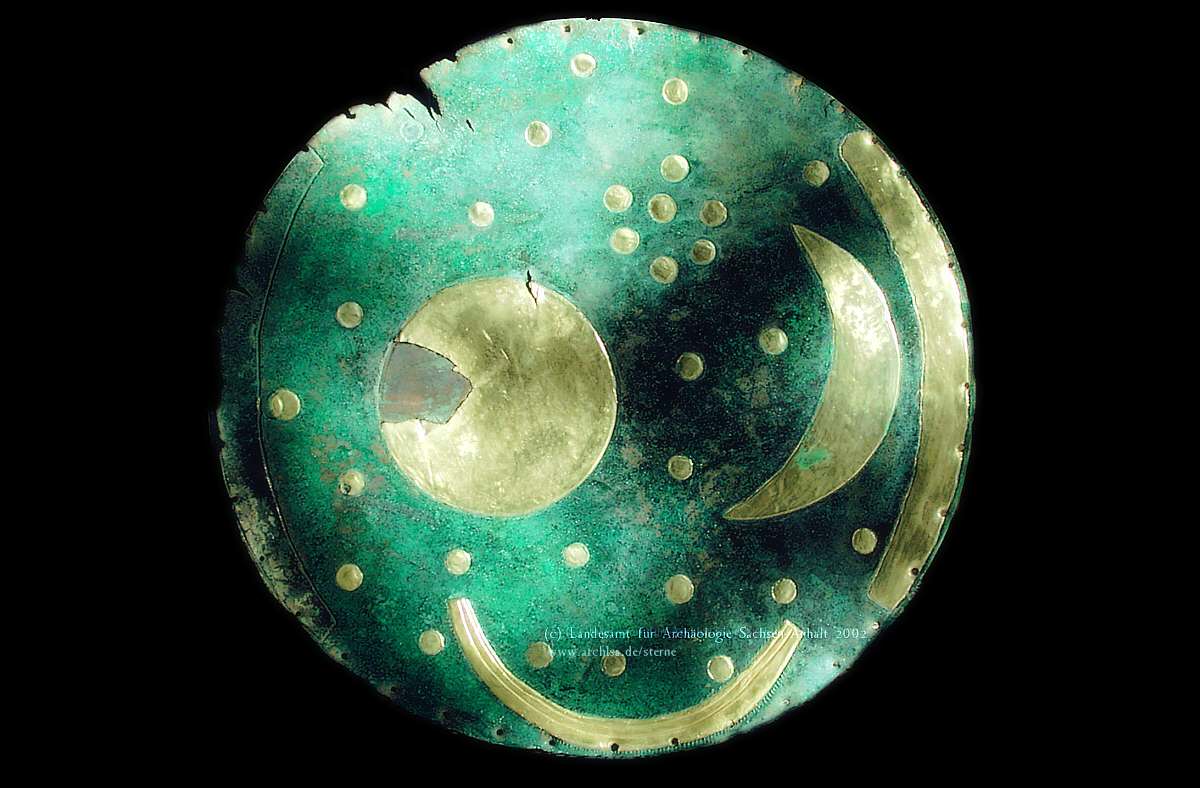
The Revelation speaks of an astrological occurrence and designation and the drawings ad description have an astrological base as the Egyptians and Moses understood and we misunderstand.
Osiris:
"Osiris (Greek language, also Usiris; the Egyptian language name is variously transliterated Asar, Aser, Ausar, Ausir, Wesir, or Ausare) is the Egyptian god of life, death, and fertility. He is one of the oldest gods for whom records have been found and first appears in the Pyramid Texts around 2400 BCE, when his cult is already well established. He was widely worshiped until the forceable suppression of paganism in the Christian era.[1][2] Osiris was not only the redeemer and merciful judge of the dead in the afterlife, but also the underworld agency that granted all life, including sprouting vegetation and the fertile flooding of the Nile River. The Kings of Egypt were associated with Osiris in death such that as Osiris rose from the dead so would they, in union with him, inherit eternal life through a process of imitative magic. By the New Kingdom all people, not just pharaohs, were believed to be associated with Osiris at death if they incurred the costs of the assimilation rituals.
What was considered paganism?
"Gen. 50 2-4: And Joseph commanded his servants the physicians to embalm his father: and the physicians embalmed Israel. And forty days were fulfilled for him; for so are fulfilled the days of those which are embalmed: and the Egyptians mourned for him threescore and ten days. And when the days of his mourning were past, Joseph spake unto the house of Pharaoh, saying, If now I have found grace in your eyes, speak, I pray you, in the ears of Pharaoh...And Joseph went up to bury his father: and with him went up all the servants of Pharaoh, the elders of his house, and all the elders of the land of Egypt...And they came to the threshing floor of Atad, which [is] beyond Jordan, and there they mourned with a great and very sore lamentation: and he made a mourning for his father seven days. And when the inhabitants of the land, the Canaanites, saw the mourning in the floor of Atad, they said, This [is] a grievous mourning to the Egyptians: wherefore the name of it was called Abel-mizraim 'meaning the breath of Egypt], which [is] beyond Jordan. Gen. 50:10-11.[Breath \Breath\ (br[e^]th), n. [OE. breth, breeth, AS. br[=ae][eth] odor, scent, breath; cf. OHG. br[=a]dam steam, vapor, breath].
Abel-mizraim can also mean the Life of Egypt.
"Although there were ethical and ceremonial considerations none of these could compare to the power of the divine eucharist, since it was literally believed to be the body (bread) and blood (ale) of the god. Since the ancient Nilotics believed that humans were whatever they eat, this sacrament was, by extension, able to make them celestial and immortal. The doctrine of the eucharist ultimately has its roots in prehistoric (symbolic) cannibalism, whose practitioners believed that the virtues and powers of the eaten would thus be absorbed by the eater. This phenomenon has been described throughout the world."
Any doctrine that did not fall under the prescribed Hebrew and later Catholic manifests. From this account, Joseph's actions would have been considered paganistic and heretical. Jacobs body under the supervision of Joseph was mummified and at his head the Book of Coming forth by Day was lain, along with the 42 negative confessions and the resurrection of Osiris was hoped for by Joseph for his father Jacob. Joseph was also a priest of On possibly a Sem priest who were to stand in [as the oldest son of Rachel] to do the ritual of mummification. Today, most Christians would be considered heretics and pagans by those in ancient times.
But what did Martin Luther the catholic priest who is given the fame of starting the Protestant religion [which is ridiculous, he remained loyal to the pope until his death and was never excommunicated] say about the Book of Revelation?
"...to my mind it bears upon it no marks of an apostolic or prophetic character... Everyone may form his own judgment of this book; as for myself, I feel an aversion to it, and to me this is sufficient reason for rejecting it." (Sammtliche Werke, 63, pp. 169-170, 'The Facts About Luther,' O'Hare, TAN Books, 1987, p. 203.)
Who is the Sun or righteousness? It is the Sun and not the Son.
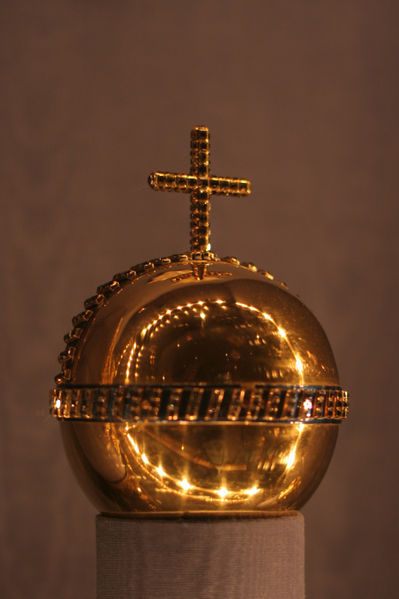
Denmark's Shen orb of the Sun
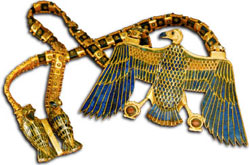
The Egyptian Shen symbol held in birds talons
Egyptologist, Richard H. Wilkinson, begins his discussion of this sign.
“Being without beginning or end, the circle evokes the concept of eternity through its form, and its solar aspect is symbolized by the Sun disc often depicted in the center of the Shen sign.”
The Christian writers appropriated the symbol for the Son of God and the Sun of God that gave life everlasting as the visible emblem of the invisible God of the universe who was known as Amen-Re/Ra to the Egyptians.
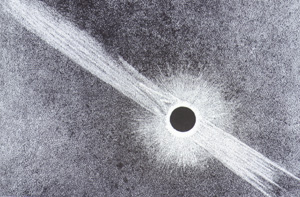
This is a drawing of the Sun rising over Egypt in 1978

This is the winged corona

Winged Sun
![]()
All of it is the same thing!!
This is a good article:
April 22, 2000
By Selwin R Cudjoe
Today Christians all over the world celebrate the resurrection of Christ: the symbolic triumph of life over death. According to Christians, Christ was crucified on Good Friday, rose from the dead on Easter Sunday and ascended into heaven subsequently. Thus, the certitude that those who believe in Him will also have everlasting life in the company of God and His panoply of angels.
Few Christians know that this exciting story is taken from the Egyptian (read African) religion, the base upon which Judeo-Christianity and Islam is built. In fact, Christianity and Islam are nothing more than African religions adapted to fill the needs of a specific time and place.
Their theology represents the development of African theology. Ideas such as the one, eternal God; the creation of the world; the future life; and three persons in one God are taken directly from the Egyptian religion. The very cross, symbol of eternal life to which Christians cling, is taken from Egyptian religion. Otto Meinardus notes that "the ankh, originally the pharaonic symbol of life, was not employed in a specifically Christian context, that is, representing salvation through the vicarious death of Christ, before the fifth or sixth century, or one or two centuries after the Christianization of the Nile Valley." (Two Thousand years of Coptic Religion.)
Three thousand years before Christianity, the Egyptians proclaimed the doctrine of eternal life and the resurrection of a spiritual body. The prayers, hymns and short litanies inscribed upon the walls of the tombs of the Egyptian kings referred to the presence of life after death. In his introduction to the Egyptian Book of the Dead (1500 BC), Wallis Budge notes that "The chief features of the Egyptian religion remained unchanged from the Vth and VI dynasties down to the period when the Egyptians embraced Christianity, after the preaching of St. Mark, the Apostle in Alexandria, AD 69, so firmly had the early beliefs taken possession of the Egyptian mind."
The resurrection story is based upon the ancient story of the resurrection of Osiris. Like Christ, he was the victim of a cruel death and a horrible mutilation before he ascended into heaven. The Egyptians believed his brother Set, who dismembered his body to deny him a second life, killed Osiris. Through her magical powers, Isis, his wife, collected the various parts of his body. Three days later, she restored him to life in the underworld where he became judge of the dead, exercising functions similar to those attributed to God. Osiris was killed on a Friday and restored on a Sunday.
Plutarch rendered one version of the Osiris story. To him, "Osiris was the god through whose sufferings and death the Egyptian hoped that his body might rise again in some transformed or glorified shape. To him who had conquered death and had become the king of the other world, the Egyptian appealed in prayer for eternal life though his victory and power" (Egyptian Book of the Dead).
Every funeral inscription written between 31 BC in Egypt right down to the prayers on the coffins of the Roman period noted that "what is done for Osiris is done also for the deceased. The state and condition of Osiris are the state and condition of the deceased." Just as Christians identified with Christ and his resurrection, followers of Egypt's monotheistic religion identified with the life and resurrection of Osiris.
The Egyptians also celebrated Easter. In the month of Choiak, ceremonies connected with Osiris's sufferings, death and resurrection were very popular. Religious observances took place in the temples and in the country while ceremonies connected with the burial of the dead, the use of amulets, and certain aspects of funeral rituals also took place.
On this Easter Sunday, it is an African religion that offers us the possibility of redemption. When Paul introduced the concept of a Redeemer born into a wicked world "who gave himself for our sins, that he might deliver us from this evil world" (Galatians: 3-4), he elaborated a theology of the Cross. He was not speaking of the Roman cross of punishment but the Egyptian ankh (cross), a symbol of Christ's victory over death that early Christians adopted during the first three centuries of their existence. In the 5th century AD the Roman-Latin cross became the Christian symbol.
Until then, the Egyptian ankh represented the living Christ: "I am crucified with Christ: nevertheless I live: yet not I but the Christ within me." The latter was a Gnostic concept. Christianity's triumph over Egyptian monotheism occurred because it represented a more democratic tendency and was suited better to the aspirations of the everyday person.
Whereas Egyptian monotheism was designed so that only kings and rich persons could gain everlasting life, they alone could afford the expensive burial cost that assured the afterlife, Christianity offered the promise of eternal life to everyone. One only had to be baptized and believe in a risen Christ. As Christianity began to spread, Jesus and Osiris were presented as saviours to whom men and women could turn to be assured of immortality.
Although the Gnostics, one of the early branches of the Christian church, regarded the resurrection as a spiritual rather than a physical event, the physicality of Christ's death and resurrection captured the imagination of the common person. By the second century AD, orthodoxy and rigidity began to shape the early Christian Church. Irenaeus, a Christian writer of the second century, argued that there could only be one Church that must be orthodox (right-thinking), catholic (universal) and apostolic (Petrine). Outside that Church "there is no salvation." By 325 AD, the Council of Nicea asserted Christ's "divinity" and assured its members that He was "begotten of the Father;" the "true God of true God."
After Nicea, the Egyptian influence on the Christian Church diminished. By 2000 AD few of us are aware of the African contribution to this important salvific event. As we enter a new millennium, it must be remembered that blackness laid the foundation of modern theology, which offers salvation to so many people."
What was the original reference for the Son of Righteous we use? Egyptian. Just as the lamb of God was also originally Kemetian.
A Lamb or Ram of God?

Psalms 134:2
Lift your hands in holiness and bless the Lord.
Psalms 63:4
Thus will I bless thee while I live: I will lift up my hands in thy name.
Ka
The ka is usually translated as "soul" or "spirit" The KA came into
existence [in the flesh] when an individual was born. It was believed that
the ram-headed god Khnum crafted the ka on his potter's wheel
at a persons birth. It was thought that when someone died they "met their
ka". A persons ka would live on after their body had died. Some tombs
included model houses as the ka needed a place to live. Offerings of food
and drink would be left at the tomb entrance so the ka could eat and
drink.
Jeremiah 18:14 "The word which came to Jeremiah from the LORD, saying,
Arise, and go down to the potter's house, and there I will cause thee to
hear my words. Then I went down to the potter's house, and, behold, he
wrought a work on the wheels. And the vessel that he made of clay was
marred in the hand of the potter: so he made it again another
vessel, as seemed good to the potter to make [it].
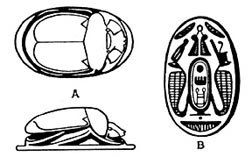
Scarab in before metamorphosis
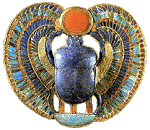
After metamorphosis Kheper
![]()
The word kheper (or hprr) means scarab, and as the animal was associated with life and rebirth. Literally the word means "he who is coming into being".
Like
Atum, Khephir was a self-created god. The scarab lays its eggs in a ball
of dung and rolls it to hide in a safe place. From this unlikely substance
the Egyptians observed new life emerging, seemingly from the Earth. Hence
he was a god of creation and resurrection.
Early in Egyptian history the beetle also came to represent the soul
rising from death - resurrected, transcendent, fully formed and ready to
make its journey and face its judgment in order to live in the Afterlife.
By the New Kingdom (1539-1070 BC), the funerary texts from the papyri
portray a scaraboid form as the most powerful symbol of life's victory
over death.
Similarly, they believed that Khephri, in the form of a gigantic scarab,
rolled the sun like a huge ball through the sky, then rolled it through
the underworld to the eastern horizon. Each morning Khephri would renew
the sun so that it could give life to all the world. As a deity closely
associated with resurrection, Khephir was believed to be swallowed by his
mother, Nut each evening and passed through her body to be reborn each
morning.
Therefore he is also closely associated with Ra [sun/life] and Atum [to be finished or it is finished]. Later funerary texts combine Khephra (scarab) with Atum (ram) into a ram-headed beetle, a portrayal of the supreme god overseeing the cycle of life and death (and Afterlife).
Khepera is a form of the sun-god Re/Ra. Khepera was specifically the neter of the rising sun. He was self-produced and usually depicted as a human with a beetle on his head, or sometimes with the beetle as his head. His name comes from the Egyptian word, kheprer or "to become".
The Atum-Ra who gives the KA and is shown as the ram or lamb-headed beetle
iconography means:
"The Sun/Life [in us] coming into the spirit being lives and is resurrection through the Supreme One who oversees the cycle of life, death and the afterlife. "
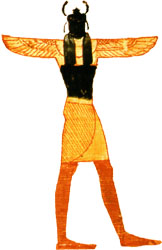
The symbol of the resurrection of man in his 'Becoming'
The winged scarab beetle.
“But to you who fear [reverence] My name "the Sun of Righteousness" shall arise with healing in His wings; and you shall go out and grow fat like stall-fed calves. You shall trample the wicked, for they shall be ashes under the soles of your feet on the day that I do this,” says the Lord of hosts.
In repeating the message when referring to an attribution the phrase 'The Sun of Righteousness with healing in his wings, those who reverence he name [what name?] shall be saved by resurrection. The example being the Khepera that was buried and then came alive. The symbol of Ra the Sun. In Christianity the symbol of Jesus became the Cross, or the lamb. The same symbology existed in Egypt but, we were just taught to reject those symbols in Egypt which made us afraid to DECODE them.
There is nothing new under the SUN, and the SUN symbol just as the Lamb symbol is not what you think! It is all Astrotheological.
As Thomas Paine said:
"The Christian religion is a parody on the worship of the Sun, in which they put a man whom they call Christ, in the place of the Sun, and pay him the same adoration which was originally paid to the Sun."
I say: The Western religions [Judaism, Christianity, Islam] appropriated the Afro-Egyptian symbols [icons, stories, images ]but did not pass on the underlying significance. From it we believe the ancient Egyptians and others worshipped the sun, moon and stars, a pantheon of god were pagans and Western religion has unearthed the truth and saved all of us from idolatry, this is as far from reality as the moon from the sun.
Blessings,
Ekowa
Click the next essay...
Sources:
http://www.inner.org/powers/powemuna.htm
http://www.touregypt.net/featurestories/amun-re.htm
http://en.wikipedia.org/wiki/Osiris
http://www.crystalinks.com/egyptsymbols.html